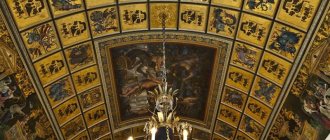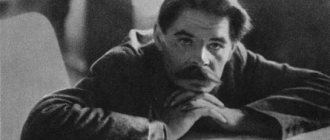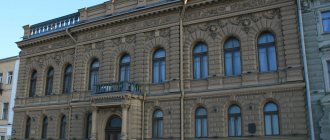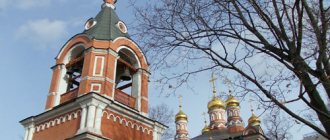The house of merchant Igumnov is one of the most famous architectural monuments of Moscow, made in the pseudo-Russian style. The mansion, located on Bolshaya Yakimanka Street in the city center, attracts attention with its incredible pretentiousness and detailed decorative design.
The building was built in 1888-1895 according to the design of the architect Nikolai Pozdeev with the participation of architects Ivan Pozdeev and Pyotr Boytsov. The customer for the construction was the Yaroslavl merchant Nikolai Igumnov.
The two-story mansion is stylized as a boyar's tower and is distinguished by exceptionally luxurious decorative design: its brick facades are decorated with carved white stone elements (weights, half-columns, belts), colored porcelain tiles depicting plants and mythical animals (based on drawings by ceramic artist Semyon Maslennikov), figured brickwork . The richly decorated window frames, as well as the massive porch with a balcony and the entrance gate with a patterned fence, attract attention. The roof has a complex shape with peaked tents, which enhances the similarity of the mansion with ancient Russian chambers.
History of the building
In the 19th century, the property on Bolshaya Yakimanka, where the mansion was later built, belonged to the merchant of the second guild Nikolai Lukyanov, under whom a wooden house stood on it, built after the fire of 1812, then to the Krasheninnikov merchants. However, in 1851, the plot was bought by the family of Yaroslavl merchants Igumnov, registering it in the name of the merchant Vera Igumnova.
In 1888, the land was inherited by Nikolai Igumnov, the owner of the Yaroslavl Big Manufactory, who decided to build a new stone one on the site of the old wooden house.
To build the mansion, Igumnov invited the architect Nikolai Pozdeev, who at that time held the position of city architect in Yaroslavl - a master of Russian eclecticism and church architecture. Pozdeev developed a project for a luxurious two-story mansion for the merchant, and in the same 1888 its construction began. However, the architect did not have to live to see its completion: in 1893 he died of tuberculosis, and work continued under the leadership of his brother Ivan Pozdeev, as well as the architect Pyotr Boytsov, who designed the interiors of the premises in the house. The construction of the mansion cost its owner a fabulous sum: according to unofficial information, Igumnov spent about a million rubles on it. Bricks for construction were ordered from Holland, and porcelain tiles were made at the factory of the Partnership for the Production of Porcelain and Earthenware Products of Matvey Kuznetsov.
There are about 40 rooms inside, including an entrance hall with a grand staircase, large and small living rooms, and several dining rooms. The interiors of the building do not have anything in common with its external appearance: some of the premises are decorated in the classicist style, some in the Art Nouveau style.
Unfortunately, the owner did not have to live in the new house for a long time - in 1901 he was exiled to the village of Alakhadzy in Abkhazia and never appeared in his Moscow house again. It is curious that contemporaries criticized the mansion for its excessive eclecticism and massive appearance.
After the October Revolution of 1917, Igumnov voluntarily handed over the house to the Soviet authorities, and until 1925 it housed the Goznak factory club. In 1925, by order of Joseph Stalin, the first Institute of Blood Transfusion in the Soviet state was opened in Igumnov’s house, of which Alexander Bogdanov was appointed director. Bogdanov promoted the method of rejuvenating the body through blood transfusions from young people to older ones, and he himself practiced exchange transfusion, going through this procedure 10 times. However, during his 11th transfusion, Bogdanov died, after which the building was transferred to the Brain Institute (ironically, Bogdanov’s brain was given to him for research).
Since 1938, Igumnov’s house has been used for the needs of the French Embassy, and since 1979, the mansion has become the official residence of French ambassadors. Nowadays, employees of the French diplomatic mission live there.
In 2010-2014, the mansion was restored.
House of merchant Igumnov on Yakimanka
Home / Places / Architecture / House of merchant Igumnov on Yakimanka
05/21/2012 13:15 Print | Email Show on map
Recently I visited the house of the merchant Igumnov - the residence of the French ambassador to Russia. Many people are familiar with the history of this house. The merchant Igumnov was a very rich man. To this day, on the satellite map of Abkhazia in the village of Alakhadzy, one can distinguish his initials: “INV” - these are cypress alleys, figuratively planted a hundred years ago. Nikolai Vasilyevich was a co-owner of the Yaroslavl Big Manufactory and had gold mines in Siberia. In 1888, he decided to equip his Moscow residence, which today houses the French Embassy.
The place on Yakimanka was in no way considered prestigious at that time. Dilapidated houses, distance from the center. Igumnov justified his choice by the fact that his childhood passed somewhere here (history has not preserved early biographical data; even the year of his birth is unknown). According to other legends, the distance from the center was required for privacy from prying eyes, because the house was not designed for ordinary life.
Be that as it may, Igumnov bought a wooden house from a certain merchant Nikolai Lukyanov, demolished it and hired a young talented city architect of Yaroslavl, Nikolai Pozdeev, for a new construction project. The architect had just turned 33 at that time, but in Yaroslavl he had already received recognition thanks to a number of high-quality buildings. By the way, it cannot be ruled out that the place near the Kaluga outpost was recommended to the customer by the architect, whose childhood was spent near Maloyaroslavets, and whose acquaintance with Moscow came from here.
The house was built in the form of a fairy-tale palace in the pseudo-Russian style. Igumnov wanted to conquer the Mother See and did not skimp. Bricks for construction were brought to the construction site directly from Holland, tiles and tiles were ordered from Kuznetsov's porcelain factories, and interior decoration was entrusted to one of the most popular architects of that time, Pyotr Boytsov. It was possible to combine the most diverse and complex components into a single whole: turrets, tents, vaulted arches, columns. The stylistic similarity of the mansion with the masterpiece of Moscow architecture of the same years - the State Historical Museum - is revealed. Today the building is a cultural heritage site of federal significance, but initially the Moscow “society” reacted to the palace more than coolly.
According to legend, the upset Igumnov refused to pay for everything that was not paid in advance, after which the architect Pozdeev committed suicide. According to another version, the architect died of a serious illness at the age of 38. This project became his last work.
The capital did not want to accept a rich and successful provincial. Soon rumors spread throughout the city that a young dancer-mistress lived in Nikolai Vasilyevich’s mansion. One day, without suffering betrayal, the merchant walled her up alive in the wall. It is unknown who spread the rumors, but Igumnov’s ill-wishers were very influential. When in 1901 a merchant decided to throw a ball in a house on Yakimanka, he, as was his habit, wanted to amaze the guests with its grandeur. For this purpose, the floor of the dance hall was completely covered with brand new gold chervonets. And the very next day in St. Petersburg, Nicholas II was reported how the Moscow merchants danced on the imperial profiles minted on coins. The reaction followed immediately: by the highest order, Nikolai Igumnov was expelled from the Mother See, without the right to return to it.
The authorities chose a place of exile that was by no means a resort: the Abkhaz coast of the Sukhumi region was then swampy, infested with malarial mosquitoes and poisonous snakes. After looking around, the disgraced merchant purchased 6 thousand acres of local swamps for next to nothing and began a new life. The first successful business was created with the help of fishermen discharged from the Don. Igumnov mastered the trade and opened the first cannery on the Black Sea coast.
Comfortable living conditions were created for the workers: seasonal workers were provided with a dormitory with rooms for two people and large smoking rooms, permanent workers received separate houses, which after a few years became their property. Igumnov brought eucalyptus trees and swamp cypresses here, which quickly drew excess moisture from the local soils. Chernozem was brought from Kuban, breeding stock was brought from Yaroslavl, and the merchant became interested in gardening. Through his efforts, plantations of tangerines, kiwi, mangoes, and tobacco appeared in these lands, the Abkhazian Bamboo enterprise began operating, and cypress alleys that have survived to this day appeared.
After the revolution, Nikolai Vasilyevich refused to emigrate to France. He voluntarily transferred his property to the state and got a job as an agronomist at the citrus state farm named after the Third International, which became the name of his former estate. Nikolai Vasilyevich died in 1924, he was buried modestly, planting his beloved cypress trees on his grave.
History sometimes likes to grimace. If the emperor took the house from the merchant for a ball on coins with his image, then after the revolution and nationalization, the building for several years became... the club of the Goznak factory. The next owner of the house on Yakimanka lived up to the gloomy legends that surrounded the mansion: in 1925, a brain research laboratory settled here for 13 years (since 1928 - the Brain Institute). During this time, the brains of Lenin, Clara Zetkin, Tsyurupa, Lunacharsky, Andrei Bely, Mayakovsky, Gorky, Pavlov, Michurin, Tsiolkovsky, Kalinin, Kirov, Kuibyshev, Krupskaya visited here...
In 1938, the mansion was transferred to the French Embassy. In 1944, President Charles de Gaulle presented awards here to the pilots of the Normandy-Niemen squadron. The Dutch brick building is still maintained in perfect condition by employees of the French diplomatic mission.
About the ghost of Igumnov's house. Rumor has it that there is still a so-called “white woman” in the French embassy building. According to legend, this small mansion was given as a gift by the merchant Igumnov to his kept woman. He himself lived in Yaroslavl, and visited the capital on visits. He usually warned the lady of his heart about his arrivals through a sent servant. But one day he arrived without warning and found his beloved with a young cornet... The owner kicked the cornet out, but after that the girl disappeared without a trace. There were rumors that the merchant killed her in his heart, and walled up her corpse in the wall of the mansion.
According to another legend, his young stoker is to blame for everything. The guy allegedly began to flirt with the pretty daughter of a merchant, for which he was soon forever excommunicated from the rich house. True, this did not end the matter. Rumor claims that before leaving, the offended stoker secretly filled the chimneys with clay shards. As a result, when the stoves in the mansion-palace were flooded, the pipes and even the walls began to make terrible sounds (for some reason, especially at night), from which the owner suffered unbearably.
But let's return to home. For the construction, a pseudo-Russian style was chosen, which was very fashionable at that time (Historical Museum, GUM store building, etc.). This style of architecture took inspiration from the image of Russian wooden towers, the most famous of which, the palace of Tsar Alexei Mikhailovich in Kolomenskoye, burned down in the 18th century.
Other decorative elements were taken from church architecture (St. Basil's Cathedral) or Yaroslavl churches, which beautifully combined brick, stone and multi-colored tiles.
On the high roof of the mansion there is pressed metal for tiles and ceramic inserts. Above the “red porch” (the main entrance there is an elegant antique double arch. The walls are made of imported Dutch brick. The window edging is made of white stone from the Moscow region. Picturesque bells, onion-shaped tent tops, blown columns. Multi-colored mosaic of rare tiles, specially painted according to the drawings of the Russian painter S. Maslennikov and manufactured at the famous Kuznetsov plant.
Pozdeev’s talent was able to combine into a single whole various volumes, topped with picturesque tents, and numerous decorative details of different genres (bells, vaulted arches, blown columns, etc.). The result was harmonious, although a little massive.
Then we go up to the second floor, open the massive door and... we find ourselves from the Middle Ages into the interiors of Louis XV! We make the transition from one century to another through a gallery in the Empire style. Reception exterior to interior. Finishing usually used for facade work. The mirror at the end of the corridor endlessly stretches the room.
- Address: Bolshaya Yakimanka, 43c1.
- Nearest metro stations: Oktyabrskaya, Polyanka.
Author of article and photos: aroundtree
City's legends
Several interesting urban myths and legends have appeared around the unusual mansion on Bolshaya Yakimanka.
According to one of them, the architect Nikolai Pozdeev did not die from tuberculosis, but committed suicide because Igumnov refused to pay additional construction costs that exceeded the original estimate. Desperate, the debt-ridden architect shot himself and, of course, cursed the mansion and its inhabitants.
Another urban legend says that at one of the ceremonial receptions in the mansion, Igumnov decided to surprise the guests by lining the floor in the front room with gold coins depicting the profile of Emperor Nicholas II. The emperor, who had heard rumors about the merchant's approach to decoration, did not appreciate such a gesture, considered it an insult and exiled Igumnov to Abkhazia. Whether there is a grain of truth in this legend is unknown, but in 1901 Igumnov was indeed exiled to the village of Alakhadzy in Abkhazia.
The third and most cruel legend says that Igumnov ordered the construction of a house in order to live in it with his mistress, the dancer Varvara. However, the merchant soon suspected the girl of treason and severely punished her by walling her up in one of the walls of the building.





